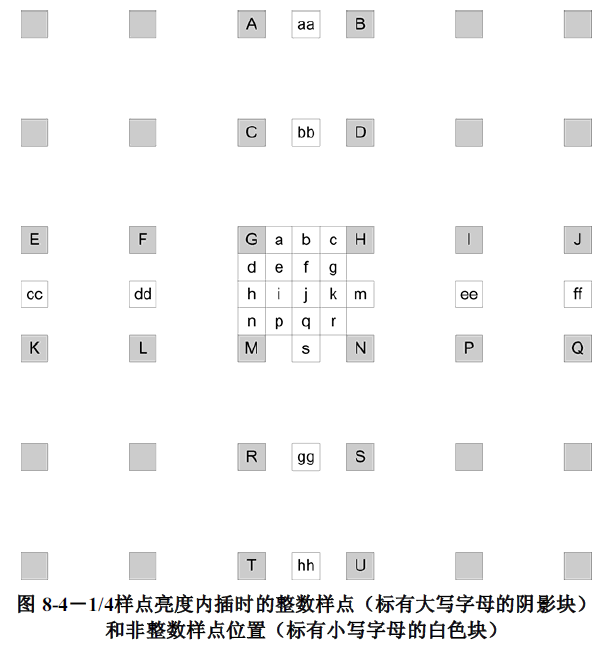源码阅读 x264 - 运动补偿
本文主要记录 x264 中的 x264_mc_init 函数,该函数主要对 x264_mc_functions_t 结构体中的函数指针进行赋值, 完成了像素内插、拷贝、求平均的等运动补偿相关函数的初始化。
void x264_mc_init(uint32_t cpu, x264_mc_functions_t *pf, int cpu_independent)
{
pf->mc_luma = mc_luma;
pf->get_ref = get_ref;
pf->mc_chroma = mc_chroma;
pf->avg[PIXEL_16x16]= pixel_avg_16x16;
pf->avg[PIXEL_16x8] = pixel_avg_16x8;
pf->avg[PIXEL_8x16] = pixel_avg_8x16;
pf->avg[PIXEL_8x8] = pixel_avg_8x8;
pf->avg[PIXEL_8x4] = pixel_avg_8x4;
pf->avg[PIXEL_4x16] = pixel_avg_4x16;
pf->avg[PIXEL_4x8] = pixel_avg_4x8;
pf->avg[PIXEL_4x4] = pixel_avg_4x4;
pf->avg[PIXEL_4x2] = pixel_avg_4x2;
pf->avg[PIXEL_2x8] = pixel_avg_2x8;
pf->avg[PIXEL_2x4] = pixel_avg_2x4;
pf->avg[PIXEL_2x2] = pixel_avg_2x2;
pf->weight = mc_weight_wtab;
pf->offsetadd = mc_weight_wtab;
pf->offsetsub = mc_weight_wtab;
pf->weight_cache = weight_cache;
pf->copy_16x16_unaligned = mc_copy_w16;
pf->copy[PIXEL_16x16] = mc_copy_w16;
pf->copy[PIXEL_8x8] = mc_copy_w8;
pf->copy[PIXEL_4x4] = mc_copy_w4;
pf->store_interleave_chroma = store_interleave_chroma;
pf->load_deinterleave_chroma_fenc = load_deinterleave_chroma_fenc;
pf->load_deinterleave_chroma_fdec = load_deinterleave_chroma_fdec;
pf->plane_copy = x264_plane_copy_c;
pf->plane_copy_swap = x264_plane_copy_swap_c;
pf->plane_copy_interleave = x264_plane_copy_interleave_c;
pf->plane_copy_deinterleave = x264_plane_copy_deinterleave_c;
pf->plane_copy_deinterleave_yuyv = x264_plane_copy_deinterleave_c;
pf->plane_copy_deinterleave_rgb = plane_copy_deinterleave_rgb_c;
pf->plane_copy_deinterleave_v210 = plane_copy_deinterleave_v210_c;
pf->hpel_filter = hpel_filter;
pf->prefetch_fenc_400 = prefetch_fenc_null;
pf->prefetch_fenc_420 = prefetch_fenc_null;
pf->prefetch_fenc_422 = prefetch_fenc_null;
pf->prefetch_ref = prefetch_ref_null;
pf->memcpy_aligned = memcpy;
pf->memzero_aligned = memzero_aligned;
pf->frame_init_lowres_core = frame_init_lowres_core;
pf->integral_init4h = integral_init4h;
pf->integral_init8h = integral_init8h;
pf->integral_init4v = integral_init4v;
pf->integral_init8v = integral_init8v;
pf->mbtree_propagate_cost = mbtree_propagate_cost;
pf->mbtree_propagate_list = mbtree_propagate_list;
pf->mbtree_fix8_pack = mbtree_fix8_pack;
pf->mbtree_fix8_unpack = mbtree_fix8_unpack;
/* 此处省略台的汇编函数初始化代码 */
......
}由于运动估计和运动补偿在 x264 中属于相对复杂的环节,其中许多函数的作用很难三言两语表述出来,因此只分析两个相对重要的例子:
- 半像素内插函数
hpel_filter() - 获取亚像素数据的函数
get_ref()
半像素内插函数
hpel_filter() 用于进行半像素插值,函数定义如下所示:
// 半像素插值公式
// b = (E - 5F + 20G + 20H - 5I + J) / 32
// d 取 1,水平滤波器
// d 取 stride,垂直滤波器(这里没有除以 32)
#define TAPFILTER(pix, d) ((pix)[x-2*d] + (pix)[x+3*d] - 5*((pix)[x-d] + (pix)[x+2*d]) + 20*((pix)[x] + (pix)[x+d]))
// x > 0 return 0;
// 0 <= x <= 255 return x;
// x > 255 return 255;
static ALWAYS_INLINE pixel x264_clip_pixel(int x) {
return ((x & ~PIXEL_MAX) ? (-x)>>31 & PIXEL_MAX : x );
}
/*
* 半像素插值
* dsth : 水平滤波得到的半像素点 (aa,bb,b,s,gg,hh)
* dstv : 垂直滤波的到的半像素点 (cc,dd,h,m,ee,ff)
* dstc : "水平 + 垂直" 滤波得到的位于 4 个像素中间的半像素点(j)
*/
static void hpel_filter( pixel *dsth, pixel *dstv, pixel *dstc, pixel *src,
intptr_t stride, int width, int height, int16_t *buf ) {
const int pad = (BIT_DEPTH> 9) ? (-10 * PIXEL_MAX) : 0;
/*
* 几种半像素点之间的位置关系
*
* X : 像素点
* H : 水平滤波半像素点
* V : 垂直滤波半像素点
* C : 中间位置半像素点
*
* X H X X X
*
* V C
*
* X X X X
*
*
*
* X X X X
*
*/
// 一行一行处理
for (int y = 0; y < height; y++) {
for (int x = -2; x < width + 3; x++) {
int v = TAPFILTER(src,stride);
dstv[x] = x264_clip_pixel( (v + 16) >> 5 );
/* transform v for storage in a 16-bit integer */
buf[x+2] = v + pad;
}
for (int x = 0; x < width; x++)
dstc[x] = x264_clip_pixel( (TAPFILTER(buf+2,1) - 32*pad + 512) >> 10 );
for (int x = 0; x < width; x++)
dsth[x] = x264_clip_pixel( (TAPFILTER(src,1) + 16) >> 5 );
dsth += stride;
dstv += stride;
dstc += stride;
src += stride;
}
}半像素插值示意图如下:

半像素点的计算关系如下:
- m : 由 B、D、H、N、S、U 计算
- h : 由 A、C、G、M、R、T 计算
- s : 由 K、L、M、N、P、Q 计算
- j : 由 cc、dd、h、m、ee、ff 计算。需要注意 j 点的运算量比较大,因为 cc、dd、ee、ff 都需要通过半像素内插方法进行计算。
获取亚像素数据
get_ref() 函数用于获取亚像素数据
const uint8_t x264_hpel_ref0[16] = {0,1,1,1,0,1,1,1,2,3,3,3,0,1,1,1};
const uint8_t x264_hpel_ref1[16] = {0,0,1,0,2,2,3,2,2,2,3,2,2,2,3,2};
// 获取运动矢量中亚像素的部分的数据
// 可以是半像素数据或者 1/4 像素数据
static pixel *get_ref( pixel *dst, intptr_t *i_dst_stride,
pixel *src[4], intptr_t i_src_stride,
int mvx, int mvy,
int i_width, int i_height, const x264_weight_t *weight ) {
/*
* qpel_idx 为 hpel_ref0[],hpel_ref1[] 的索引值
*
* 运动矢量 (mvy,mvx) 位置和 qpel_idx 对应关系如下
* 0pixel | 0p | 1/4p | 1/2p | 3/4p | 1pixel |
* --------+--------+--------+--------+--------+--------+
* 0p | 0<<2+0 | 0<<2+1 | 0<<2+2 | 0<<2+3 | |
* --------+--------+--------+--------+--------+--------+
* 1/4p | 1<<2+0 | 1<<2+1 | 1<<2+2 | 1<<2+3 | |
* --------+--------+--------+--------+--------+--------+
* 1/2p | 2<<2+0 | 2<<2+1 | 2<<2+2 | 2<<2+3 | |
* --------+--------+--------+--------+--------+--------+
* 3/4p | 3<<2+0 | 3<<2+1 | 3<<2+2 | 3<<2+3 | |
* --------+--------+--------+--------+--------+--------+
* 1pixel |
* --------+
* 计算出来后
* 0pixel | 0p | 1/4p | 1/2p | 3/4p | 1pixel |
* --------+--------+--------+--------+--------+--------+
* 0p | 0 | 1 | 2 | 3 | |
* --------+--------+--------+--------+--------+--------+
* 1/4p | 4 | 5 | 6 | 7 | |
* --------+--------+--------+--------+--------+--------+
* 1/2p | 8 | 9 | 10 | 11 | |
* --------+--------+--------+--------+--------+--------+
* 3/4p | 12 | 13 | 14 | 15 | |
* --------+--------+--------+--------+--------+--------+
* 1pixel |
* --------+
*/
int qpel_idx = ((mvy&3)<<2) + (mvx&3);
// offset 是匹配块相对当前宏块的整数偏移量
int offset = (mvy>>2)*i_src_stride + (mvx>>2);
// src[4] 中有 4 个分量,分别代表:整像素点 Full,水平半像素点 H,垂直半像素点 V,对角线半像素点 C 的取值
// 几种半像素点的值已经提前计算出来,而 1/4 像素点的值则是临时计算
// 注意上述几种半像素点是按照 "分量" 的方式存储的
// src1[] 为选择后的半像素数据
// 选择了 Full,H,V,C 几种 "分量" 中的 1 种
pixel *src1 = src[x264_hpel_ref0[qpel_idx]] + offset + ((mvy&3) == 3) * i_src_stride;
// qpel_idx & 5,5 是 0101, 代表 qpel_idx 最后 1 位(对应 x 分量)为 1 或者倒数第 3 位为 1(对应 y 分量)
// 即 x 或者 y 中有 1/4 或者 3/4 像素点(此时需要 1/4 像素内插)
// 只有需要 1/4 内插的点才会 qpel_idx & 5!=0。这时候需要通过线性内插获得 1/4 像素点的值
if (qpel_idx & 5) /* qpel interpolation needed */ {
// src2[] 为用于内插的数据另一组数据
pixel *src2 = src[x264_hpel_ref1[qpel_idx]] + offset + ((mvx&3) == 3);
// 进行 1/4 像素线性内插
pixel_avg( dst, *i_dst_stride, src1, i_src_stride,
src2, i_src_stride, i_width, i_height );
if (weight->weightfn )
mc_weight(dst, *i_dst_stride, dst, *i_dst_stride, weight, i_width, i_height);
return dst;
} else if (weight->weightfn ) {
mc_weight(dst, *i_dst_stride, src1, i_src_stride, weight, i_width, i_height);
return dst;
} else {
*i_dst_stride = i_src_stride; // 只需要半像素滤波
return src1;
}
}